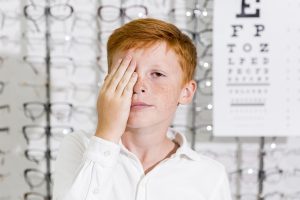Communication between the sensory organ, the central nervous system and the motor response is essential for proper cognitive, motor and sensory development.
In order to clearly define what visual functions are and why it is essential to enhance them, it is necessary to elaborate on a few aspects.
Functional visual skills
A number of scientific studies published in American scientific journals listed in PubMed, focus only on certain abilities, and correlate them with certain abnormalities of visual function and neurodevelopmental disorders.
A full description of the functional visual skills includes:
- visual acuity: sharpness of perceived images (in Italy this is quantified in tenths);
- focusing capacityThe ability to maintain continuous use of focus at close range. It is necessary to learn to control the focusing system, in order to perform one's tasks, in an automated manner;
- eye co-ordinationThe ability of the eyes to work together when performing any task. Slight differences in the ability of the two eyes to fixate and pursue with their gaze (phorias) can cause blurred vision, double vision, difficulty in processing several stimuli at once and headaches. Pathological deficiencies in this aspect can, therefore, give rise to eye rotation (tropes), strabismus, double vision and suppression;
- eye movementsGood control of this skill allows sophisticated movements, such as following a ball, directing the eyes while reading and heading, guiding movements in sports that require pursuits;
- reproduction of forms(ocular and fine manual comprehension and co-ordination) for the comprehension of written language, the ability to perceive basic shapes (letters and numbers for example) and to copy them during reading-writing is necessary;
- peripheral vision: the outermost portion of the visual field that a person can experience while holding their head and eyes in a central point;
- binocularity and stereopsisthree-dimensional vision, which allows the fusion of the two images recorded individually by each eye, which produces depth perception in the brain.
The assessment of visual function
The correct assessment of visual function allows us to understand how we see, which visual abilities can excel and which are deficient.
Non-treatment of eye movement abnormalities causes:
- a cognitive and motor learning difficulty, making reading and subsequent text comprehension complex, impairing the motor quality directed towards an object of interest, causing stress, central fatigue and insecurity;
- a visual dysfunction. This impairs the proprioceptive system and the awareness of one's body in space, as well as affecting the organisation of the kinetic chains that reach the feet by altering loads and supports;
- a convergence deficit. In adulthood it causes irregular heart rate, changes the amplitude and frequency of the electroencephalogram, produces a disturbance in the volume and rhythm of respiration, an increase in blood pressure, an electromyographic change in the trapezius muscle, an increase in skin temperature, and finally postural changes.
Sensorimotor rehabilitation
 Sensorimotor re-education aimed at the developmentally disabled child with neurodevelopmental disorders, (e.g. DSA, ADHD, DCD, dyspraxia and autism), aims to optimise visual-cognitive performance in reading, writing, coarse and fine visual-motor co-ordination and the correct management of executive functions, in support of traditional therapies.
Sensorimotor re-education aimed at the developmentally disabled child with neurodevelopmental disorders, (e.g. DSA, ADHD, DCD, dyspraxia and autism), aims to optimise visual-cognitive performance in reading, writing, coarse and fine visual-motor co-ordination and the correct management of executive functions, in support of traditional therapies.
Specifically, this re-education consists of performing a series of exercises that aim to train patients through visual stimuli by linking them directly to motor stimuli.
The quality of visual function and its impact
Vision is a complex neurological process that enables us to identify, interpret and understand external reality by means of sensors (the eyes), capturing visual information through light and evaluating it as a basis for our thoughts and actions. Visual function is also linked to other abilities including motor coordination and balance, language skills, psychological (in a broad sense) and auditory skills. Therefore, vision inevitably influences various aspects of human beings as well as their posture, fine motor skills and motor co-ordination.
To have good vision is not simply to have a visual acuity of 10/10, but to derive meaning from what you see.
The quality of visual function depends primarily on visual abilities, which are managed by the central nervous system (CNS).
For example: the ability to move one's gaze continuously from the desk to the blackboard depends, in addition to complex saccadic programming, on the correct co-ordination of the oculomotor muscles that deal with eye movements. In particular, convergence and divergence, as well as accommodation of the crystalline lens, which, thanks to the ciliary muscles, allows images to be focused within short distances from the observer.
The eyes inform the S.N.C. about the position of the object of interest in space and, based on this location, the central control sends the data for focusing it.
Every individual learns to see and develops their visual-perceptual skills differently depending on their experiences. Without proper exposure to visual stimulus in the first three years of life, one could not, in fact, develop proper vision even in the presence of perfectly functioning eyes (think of cortical blindness).
Vision is therefore a process that develops from birth through interactions with the environment. It is not, as is often perceived by the 'uninitiated', a static, rigid and mechanical optical system, but rather, an active and dynamic process that requires continuous interactions of the organism with its environment.
Re-education and strengthening
The areas of intervention for re-education and enhancement of visual function are:
- primary motor reflexes, developmental stages
- visual skills, auditory integration
- coordination, balance
- rhythm, tempo
- concentration, attention
- space-time
This is the only way to create new perceptual and motor organisations, indicative of proper visual, perceptual and cognitive maturation.
Short biography Elena Spigno
Master in Optics and Optometry
Master in Psychomotricity and Early Intervention
BRMT Technician Level 3
Postural Gymnastics Technician
Elena Spigno
